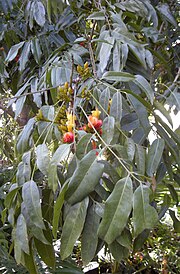Difference between revisions of "Castanospermum australe"
(Created page with '{{SPlantbox |familia=Fabaceae |genus=Castanospermum |species=australe |common_name=Moreton Bay Chestnut, Blackbean |name_ref=Wikipedia |habit=tree |habit_ref=Wikipedia |Max ht bo…') |
|||
| Line 19: | Line 19: | ||
'''''Castanospermum australe''''' ('''Moreton Bay Chestnut''' or '''Blackbean'''), the only species in the genus '''''Castanospermum''''', is a [[flowering plant]] in the family [[Fabaceae]], native to the east coast of [[Australia]] in [[Queensland]] and [[New South Wales]], and to the Pacific islands of [[Vanuatu]] and [[New Caledonia]]. | '''''Castanospermum australe''''' ('''Moreton Bay Chestnut''' or '''Blackbean'''), the only species in the genus '''''Castanospermum''''', is a [[flowering plant]] in the family [[Fabaceae]], native to the east coast of [[Australia]] in [[Queensland]] and [[New South Wales]], and to the Pacific islands of [[Vanuatu]] and [[New Caledonia]]. | ||
| − | |||
It is a large [[evergreen]] [[tree]] growing to {{convert|40|m}} tall, though commonly much smaller. The [[leaf|leaves]] are {{convert|15|cm}} long and {{convert|6|-|7|cm}} broad, [[pinnate]], with 11-15 leaflets. The [[flower]]s are bicoloured red and yellow, {{convert|3|-|4|cm}} long, produced in [[raceme]]s {{convert|6|cm}} long. The [[fruit]] is a cylindrical [[legume|pod]] {{convert|12|-|20|cm}} long and {{convert|4|-|6|cm}} diameter, the interior divided by a spongy substance into three to five cells, each of which contains a large [[chestnut]]-like [[seed]]. | It is a large [[evergreen]] [[tree]] growing to {{convert|40|m}} tall, though commonly much smaller. The [[leaf|leaves]] are {{convert|15|cm}} long and {{convert|6|-|7|cm}} broad, [[pinnate]], with 11-15 leaflets. The [[flower]]s are bicoloured red and yellow, {{convert|3|-|4|cm}} long, produced in [[raceme]]s {{convert|6|cm}} long. The [[fruit]] is a cylindrical [[legume|pod]] {{convert|12|-|20|cm}} long and {{convert|4|-|6|cm}} diameter, the interior divided by a spongy substance into three to five cells, each of which contains a large [[chestnut]]-like [[seed]]. | ||
| − | |||
The seeds are poisonous, but become edible when carefully prepared by pounding into flour, leaching with water, and roasting. | The seeds are poisonous, but become edible when carefully prepared by pounding into flour, leaching with water, and roasting. | ||
| Line 40: | Line 38: | ||
<gallery perrow=5> | <gallery perrow=5> | ||
Image:Upload.png| photo 1 | Image:Upload.png| photo 1 | ||
| − | Image: | + | Image:Castanospermum australe 01 Pengo.jpg|Pods |
| − | Image: | + | Image:200410 Castanospermum australe.JPG| Small ''C. asutrale'' tree |
</gallery> | </gallery> | ||
Latest revision as of 02:52, 17 July 2010
| Habit | tree
| |
|---|---|---|
| Height: | ⇕ | 40 m"m" can not be assigned to a declared number type with value 40. |
| Features: | ✓ | evergreen, flowers |
|---|---|---|
| Flower features: | ❀ | red, orange, yellow |
|
Fabaceae > |
australe > |
If this plant info box on watering; zones; height; etc. is mostly empty you can click on the edit tab and fill in the blanks!
Castanospermum australe (Moreton Bay Chestnut or Blackbean), the only species in the genus Castanospermum, is a flowering plant in the family Fabaceae, native to the east coast of Australia in Queensland and New South Wales, and to the Pacific islands of Vanuatu and New Caledonia.
It is a large evergreen tree growing to 40 m tall, though commonly much smaller. The leaves are 15 cm long and 6 - 7 cm broad, pinnate, with 11-15 leaflets. The flowers are bicoloured red and yellow, 3 - 4 cm long, produced in racemes 6 cm long. The fruit is a cylindrical pod 12 - 20 cm long and 4 - 6 cm diameter, the interior divided by a spongy substance into three to five cells, each of which contains a large chestnut-like seed.
The seeds are poisonous, but become edible when carefully prepared by pounding into flour, leaching with water, and roasting.
Cultivation
Propagation
Pests and diseases
Varieties
Gallery
References
External links
- w:Castanospermum australe. Some of the material on this page may be from Wikipedia, under the Creative Commons license.
- Castanospermum australe QR Code (Size 50, 100, 200, 500)



